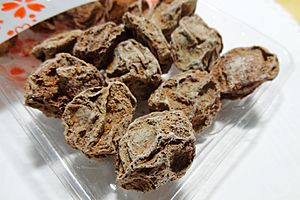Li hing mui facts for kids
Li hing mui is a special kind of salty dried Chinese plum. In Mainland China, it's known as huamei. This plum has a very strong and unique flavor. People often say it's an "acquired taste" because it mixes sweet, sour, and salty all at once!
Li hing mui first came from a place in China called Guangdong Province. The name "li hing mui" means "traveling plum." In the Cantonese language, "li hing" means "traveling," and "mui" means "plum."
Li Hing Powder
Li hing mui powder is made from the skin of plums that have been pickled. This pickling mix usually includes things like licorice, red food coloring, salt, and sugar. Sometimes, artificial sweeteners are also added.
This powder is often used to add flavor to many different foods. You can sprinkle it on candies or fruits like pineapples, mangoes, guavas, and apples.
In the United States, li hing mui powder is very popular in Hawaii. Kids there love to put it on sour gummy bears, sour gummy worms, and other sour candies. They also sprinkle it on shave ice, popcorn, and a crunchy snack called arare (which is also known as mochi crunch).
There are different kinds of li hing powder. The "red" powder is popular for fruits and certain red plum types. A "white" powder is often used on dried plums.
Li Hing in Drinks
Sometimes, li hing powder is used to add a special taste to drinks. In Hawaii, some places use this powder to rim glasses instead of regular salt. This gives drinks a unique salty, sweet, and sour flavor. People feel it adds a tart and tangy twist.
You can also find the whole li hing mui plum added to some drinks. For example, in China, huamei plums are sometimes put into bottles of rice wine, much like olives are used in a martini. When the plums sit in the drink for a while, they give it a reddish color and their special flavor.
Li Hing in the United States
Li hing mui became very popular in Hawaii thanks to a person named Yee Sheong. In the early 1900s, Yee Sheong started bringing li hing mui and other dried fruit snacks, like crack seed, from China to Hawaii.
Yee Sheong's efforts began the "li hing mui craze" in Hawaii. The company he started, Yick Lung, helped this popularity grow. Today, you can find li hing mui in markets that sell Hawaiian and Asian foods.
In the 1970s, a popular gift for kids in Hawaii was a lei (a necklace) made from Yick Lung crack seeds.
Images for kids





